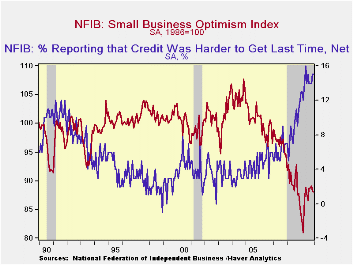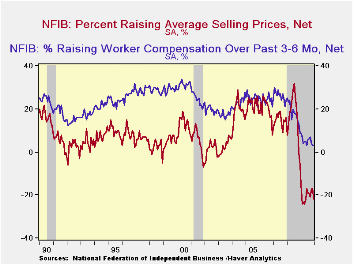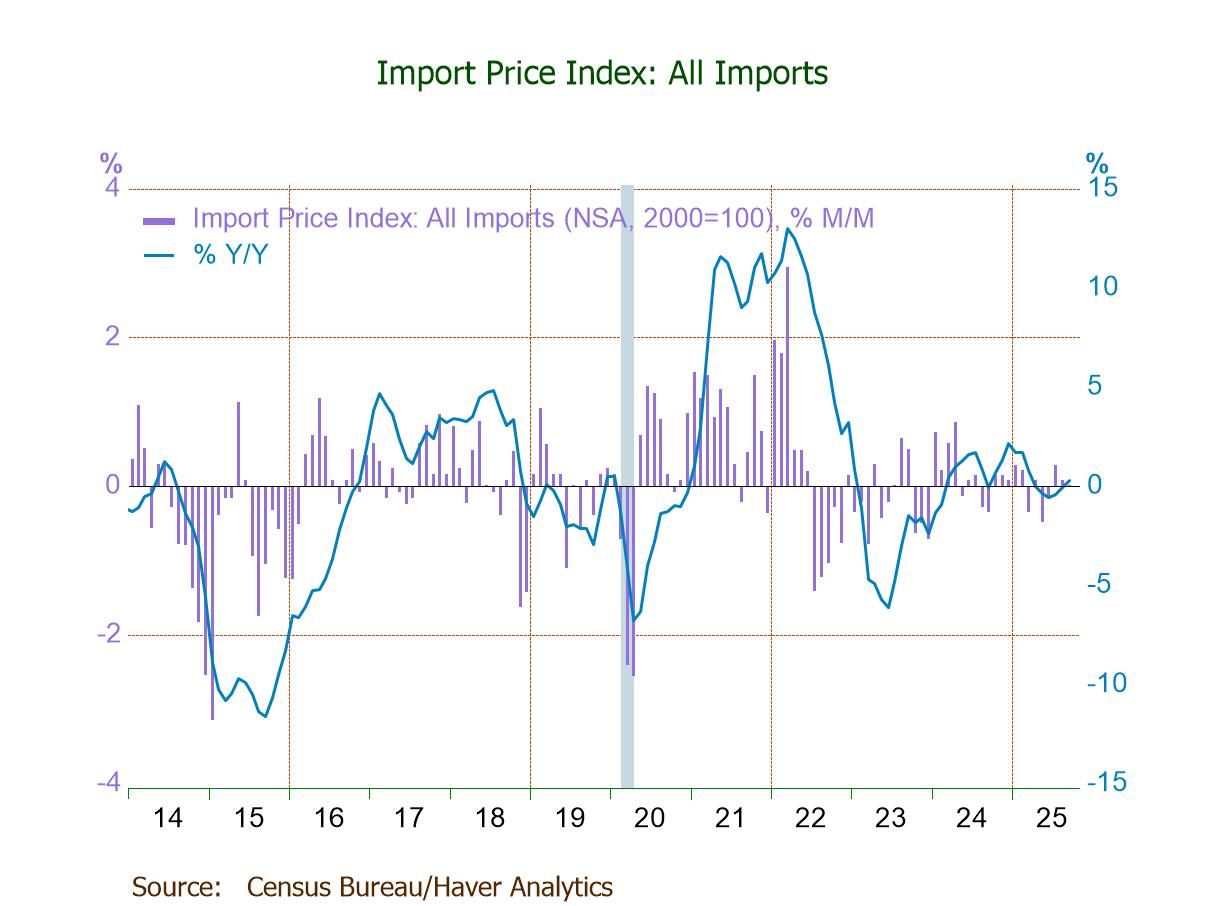 Global| Jan 13 2010
Global| Jan 13 2010U.S. Small Business Optimism Slips Again As Credit Remains Tight
by:Tom Moeller
|in:Economy in Brief
Summary
Earlier improvement in small business' optimism slipped again last month. The National Federation of Independent Business (NFIB) reported their December small business optimism index dipped 0.3% to 88.0. This second consecutive slight [...]
 Earlier
improvement in small business' optimism slipped again last month. The
National Federation of Independent Business (NFIB) reported their
December small business optimism index dipped 0.3% to 88.0. This second
consecutive slight decline followed several months of increase after
reaching a March low of 81.0. During the last ten years, there
has been an 85% correlation between the level of the NFIB index and the
two-quarter change in real GDP.
Earlier
improvement in small business' optimism slipped again last month. The
National Federation of Independent Business (NFIB) reported their
December small business optimism index dipped 0.3% to 88.0. This second
consecutive slight decline followed several months of increase after
reaching a March low of 81.0. During the last ten years, there
has been an 85% correlation between the level of the NFIB index and the
two-quarter change in real GDP.
Credit conditions remained as tight as they've been since the "credit crunch" recession of 1980. The percentage of firms reporting that credit was harder to get was stable m/m at a net 15 but that was roughly triple the percentage from 1994 to 2007. The percent borrowing at least once last quarter was stable at 33% but that was down from the high of 46% during 2006.
The percentage
of small businesses expecting the economy to improve dipped slightly
m/m to 2 after a sharp November decline. The latest was down from the
May high of 12.  The percentage which thought that now was a good time
to expand the business also slipped to 7 though it remained sharply
improved from this winter.
The percentage which thought that now was a good time
to expand the business also slipped to 7 though it remained sharply
improved from this winter.
Hiring intentions have responded negatively to recent weakness in overall business sentiment. The percentage of firms planning to raise employment remained in a net-layoff region, though it has improved from the March low. For now, the percentage of firms with one or more job openings improved modestly to 10% during December. During the last ten years there has been a 74% correlation between the NFIB employment percentage and the six-month change in nonfarm payrolls. Also stable in the negative region was the percentage expecting credit conditions to ease.
On the pricing front deflation
continued. The percentage of firms actually raising
prices at -22% (indicating deflation) slipped from the prior several
months and was near the record low. During the last ten years there has
been a 60% correlation between the six-month change in the producer
price index and the level of the NFIB price index
The percentage of firms planning to raise prices slipped again to a net 3 though that remained up from the March low of zero. Finally, the percentage planning to raise worker compensation fell to 1.
The largest, single most important problems seen by business were poor sales (34%), taxes (20%, near its highest level since 2007), government requirements (13%), insurance cost & availability (7%), competition from large businesses (6%) and inflation (2%).
About 24 million small businesses exist in the United States. Small business creates 80% of all new jobs in America and the NFIB figures can be found in Haver's SURVEYS database.
| Nat'l Federation of Independent Business | December | November | October | Y/Y | 2009 | 2008 | 2007 |
|---|---|---|---|---|---|---|---|
| Small Business Optimism Index (SA, 1986=100) | 88.0 | 88.3 | 89.1 | 3.3% | 86.7 | 89.8 | 96.7 |
| Percent of Firms Expecting Economy To Improve | 2 | 3 | 11 | -13 | -0 | -10 | -4 |
| Percent of Firms With One or More Job Openings | 10 | 8 | 8 | 14 | 9 | 18 | 24 |
| Percent of Firms Reporting That Credit Was Harder To Get | 15 | 15 | 14 | 12 | 14 | 9 | 6 |
| Percent of Firms Raising Avg. Selling Pric1es (Net) | -22 | -17 | -17 | -6 | -20 | 17 | 15 |
Tom Moeller
AuthorMore in Author Profile »Prior to joining Haver Analytics in 2000, Mr. Moeller worked as the Economist at Chancellor Capital Management from 1985 to 1999. There, he developed comprehensive economic forecasts and interpreted economic data for equity and fixed income portfolio managers. Also at Chancellor, Mr. Moeller worked as an equity analyst and was responsible for researching and rating companies in the economically sensitive automobile and housing industries for investment in Chancellor’s equity portfolio. Prior to joining Chancellor, Mr. Moeller was an Economist at Citibank from 1979 to 1984. He also analyzed pricing behavior in the metals industry for the Council on Wage and Price Stability in Washington, D.C. In 1999, Mr. Moeller received the award for most accurate forecast from the Forecasters' Club of New York. From 1990 to 1992 he was President of the New York Association for Business Economists. Mr. Moeller earned an M.B.A. in Finance from Fordham University, where he graduated in 1987. He holds a Bachelor of Arts in Economics from George Washington University.






